(Written by the webquest author, Professor Jon Kahl, Milwaukee, Wisconsin, USA, April 2004)
I’m a professor of atmospheric science at the University of Wisconsin-Milwaukee. Every seven years I get a sabbatical, a break from my regular work of teaching courses in meteorology and researching air pollution and climate change. This time around I decided to do something a bit different: I received a Fulbright grant to conduct air pollution research in Mexico City. For four months I lived in Mexico City with my family, working with scientists at the University of Mexico’s Atmospheric Science Center, conducting research related to air pollution and acid rain in Mexico, and visiting lots of interesting places. This webquest is one of the products of this effort.
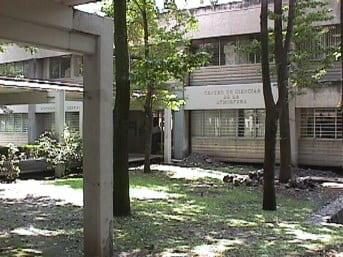 |
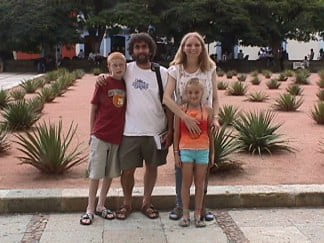 |
| The Atmospheric Science Center in Mexico City. | My family in Oaxaca, a beautiful city in southern Mexico. |
In October 2003 I visited the El Tajín ruins on the east coast of Mexico, in the state of Veracruz. It was a fantastic experience, one that I’ll never forget. The 5-hour bus ride from Mexico City to Papantla was spectacular, although it was also a bit terrifying crossing the Sierra Madre Oriental mountains on a rickety bus. Papantla was beautiful. The people were extremely friendly, and of course the El Tajín ruins were awesome.
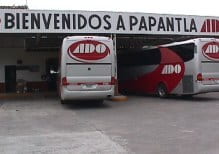 |
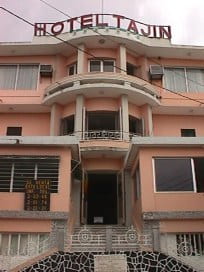 |
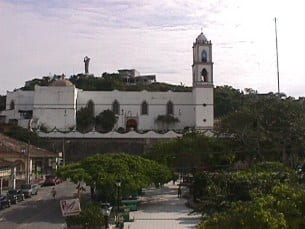 |
| Arriving at the bus station. | My hotel in Papantla, Veracruz. | The plaza in the center of Papantla. The Voladores pole at the right is the same one that is filmed in the video clip. The statue at the top of the hill is a huge monument to the Voladores. |
The food in Papantla was one of the best parts of my trip to El Tajín. I still drool every time I think about it. Here are photos of some of my favorite dishes:
 |
 |
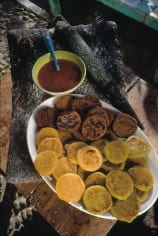 |
| Molotes: corn flour dumplings stuffed with spiced meat, usually pork (I got mine with chicken). | Caldo Xochitl (hot flower soup): a filling soup with potatoes, carrots and chicken. | Bocoles rellenos: sweet, thick corn pancakes filled with cheese, meat or egg. I had these for breakfast. |
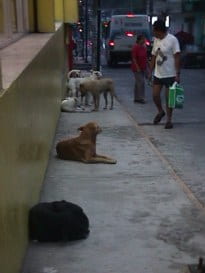 |
| There were a lot of friendly dogs running around the streets of Papantla. |
I spent a memorable day at El Tajín, looking around, climbing pyramids, taking pictures and talking to the people who work there.
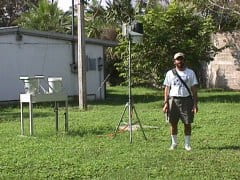 |
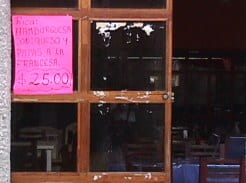 |
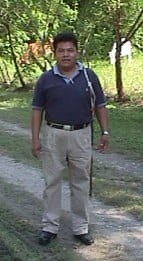 |
| Here I am standing next to the acid rain and meteorology monitoring equipment at El Tajín. | The cafe on the grounds of the El Tajín ruins has an international menu. | This is Domingo Morales Garcia, one of the staff members responsible for collecting precipitation samples. Mr. Morales is a Totonac like the original inhabitants of El Tajín. About 260,000 Totonacs survive in modern Mexico. |
Here are a few pictures taken in December 2003 at the Center for Atmospheric Sciences holiday party, held at a Chinese restaurant in Tlalpan, the southern section of Mexico City.
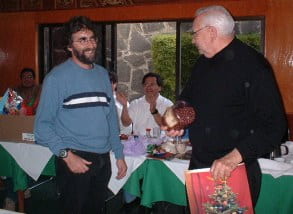 |
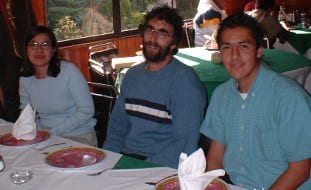 |
| I’m presenting a gift to my colleague Dr. Bravo: a jar of his favorite candy, chocolate-covered raisins (pasas de chocolate). You can see Dr. Soto at the left. Pablo Sanchez is clapping, probably because he thinks he’s going to get some pasas later. | Here I’m sitting with two of my amigos, chemist Anna Alarcón and Jorge Pachón, a graduate student from Colombia. |
After the fun in Mexico was over, there was still a lot of work to be done.
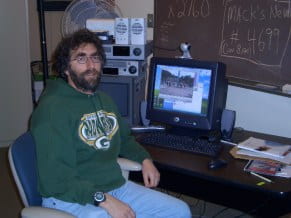 |
| Here I’m working in a computer lab on the University of Wisconsin-Milwaukee campus, transferring the Voladores video clip from VHS tape to digital formats. |
I hope you enjoyed the webquest!
A lot of people deserved to be thanked for their help throughout the various stages of this project. In particular, I thank my family for taking four months out of their busy lives to accompany me on our Mexican adventure. I thank Dr. Humberto Bravo and colleagues at the Centro de Ciencias de la Atmosfera for providing me an office (Humberto called it a ‘Taliban cave’) and a pleasant working environment. I thank Mr. Julio Pineda of Papantla, Veracruz for selling me the Voladores video clip for only $12, and Amy Mangrich of the University of Wisconsin-Milwaukee for helping me to digitize the clip.